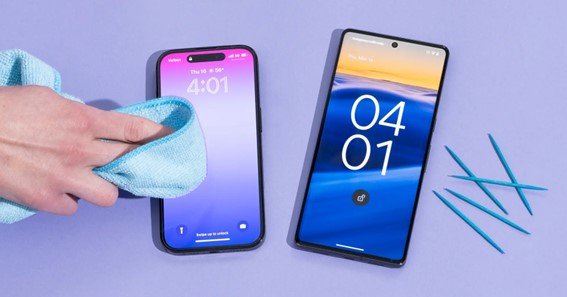In today’s world, maintaining the durability and cleanliness of surfaces is more important than ever. From the smartphones we carry to the kitchen countertops we use daily, surfaces are constantly subjected to wear and tear, smudges, and environmental exposure. Whether it’s about keeping your devices looking pristine or ensuring the longevity of materials in industrial settings, advancements in surface technology are reshaping how we interact with the objects around us.
One of the most promising innovations in this field is the development of anti-fingerprint coatings. These coatings prevent smudges and marks from accumulating on frequently touched surfaces like phones, tablets, and appliances. By reducing the appearance of fingerprints, these coatings keep surfaces cleaner for longer while enhancing their durability. In this article, we will explore how the latest developments in surface protection are leading to a new era of durability and cleanliness, transforming both consumer products and industrial applications.
1. The Rising Demand for Surface Protection
As technology and design evolve, there’s a growing emphasis on surfaces that are both durable and easy to maintain. Modern consumers expect their gadgets and household items to look good and function flawlessly, even after extended use. Likewise, industries such as automotive, construction, and manufacturing require surfaces that can withstand environmental stresses, such as corrosion, heat, and abrasion, without sacrificing cleanliness.
The demand for surface protection has driven innovation in materials science, leading to the development of coatings that provide a higher level of durability and hygiene. In a world where appearance, functionality, and cleanliness are increasingly intertwined, advanced surface coatings have become indispensable.
Durability Meets Cleanliness
Traditionally, durability and cleanliness were considered separate concerns. Durable surfaces often meant heavy, industrial-grade materials that were hard to clean, while easy-to-clean surfaces often lacked long-term durability. However, new materials and coatings are bridging this gap, allowing surfaces to be both durable and easy to maintain.
Advanced coatings now provide a dual function: they protect surfaces from physical damage, such as scratches and impact, while also repelling dirt, oils, and other contaminants. This evolution is particularly significant for devices and appliances that are handled frequently, where maintaining a clean and polished appearance is just as important as preserving their structural integrity.
2. Innovative Coatings for Enhanced Durability
While cleanliness is a key focus for consumers, industries place equal importance on durability. In sectors like automotive, aerospace, and construction, surfaces are exposed to extreme conditions that can cause damage over time. As a result, coatings that provide enhanced durability have become essential for ensuring long-term performance.
Scratch-Resistant Coatings
Scratches are one of the most common forms of surface damage, especially in high-use items such as smartphones, watches, and furniture. Scratch-resistant coatings have been developed to provide an invisible shield that absorbs impact and prevents scratches from forming. These coatings are typically applied to glass surfaces, such as touchscreens, or to polished metal and plastic finishes, ensuring they remain flawless even after months or years of use.
For industries, scratch-resistant coatings are particularly useful in applications where aesthetic quality is crucial, such as automotive exteriors, building materials, and high-end consumer products. These coatings help reduce maintenance costs by extending the life of materials and preventing cosmetic damage.
Anti-Corrosion Coatings
In industrial settings, corrosion is a significant challenge, particularly for metals exposed to harsh environments. Anti-corrosion coatings protect metal surfaces from the damaging effects of moisture, chemicals, and salt, ensuring that machinery, vehicles, and infrastructure remain functional and safe. These coatings are often used in marine environments, construction, and transportation, where metal components are vulnerable to rust and degradation.
By applying anti-corrosion coatings, industries can reduce the need for frequent repairs and replacements, improving the sustainability and cost-effectiveness of their operations.
UV-Resistant Coatings
Prolonged exposure to sunlight can cause materials like plastics, fabrics, and even some metals to fade, degrade, or become brittle. UV-resistant coatings are designed to block harmful ultraviolet rays, preventing discolouration and material weakening. These coatings are essential for outdoor applications, such as solar panels, outdoor furniture, and vehicle exteriors, where long-term exposure to sunlight is inevitable.
By protecting surfaces from UV damage, these coatings help maintain both the appearance and functionality of materials, ensuring they remain in good condition for years to come.
3. Self-Cleaning Surfaces: The Next Frontier
In addition to anti-fingerprint coatings, self-cleaning surfaces are emerging as a revolutionary development in surface technology. Self-cleaning coatings use nanotechnology to create surfaces that actively repel dirt, water, and oils, making them nearly maintenance-free. These coatings are particularly useful in environments where hygiene is critical, such as hospitals, kitchens, and public transport systems.
Hydrophobic and Superhydrophobic Coatings
Hydrophobic coatings are designed to repel water, causing it to bead up and roll off the surface, taking dirt and other contaminants with it. This technology is already being used on windows, solar panels, and vehicle windshields, where it helps keep surfaces clear and reduces the need for frequent cleaning.
Superhydrophobic coatings take this concept a step further, creating surfaces that are almost impossible to wet. These coatings are being explored for use in a wide range of applications, from industrial machinery to consumer electronics, where maintaining a clean, dry surface is essential for performance and longevity.
Anti-Microbial Coatings
As concerns about hygiene and public health grow, anti-microbial coatings are becoming increasingly popular. These coatings are infused with materials that inhibit the growth of bacteria, viruses, and fungi on surfaces. They are particularly valuable in healthcare settings, where reducing the spread of infections is critical, but they are also finding use in everyday products such as door handles, handrails, and kitchen surfaces.
By preventing the growth of harmful microorganisms, anti-microbial coatings contribute to cleaner, safer environments and reduce the need for harsh cleaning chemicals.
4. Sustainable Solutions: The Environmental Impact of Advanced Coatings
As industries and consumers become more environmentally conscious, there is a growing demand for sustainable surface protection solutions. Advanced coatings not only extend the life of products, reducing waste, but many are also designed to be more environmentally friendly in their production and application.
Water-based coatings, for example, are becoming more common as a safer, less toxic alternative to solvent-based coatings. These coatings produce fewer volatile organic compounds (VOCs), which are harmful to both human health and the environment. Additionally, some manufacturers are developing biodegradable coatings that break down naturally at the end of their lifecycle, further reducing their environmental footprint.
5. The Future of Surface Protection
We are only scratching the surface of what advanced coatings can achieve. Research and development are continuing to push the boundaries of material science, with new solutions emerging that will further enhance surface durability and cleanliness.
Self-Healing Coatings
One of the most exciting developments in surface protection is the creation of self-healing coatings. These coatings have the ability to repair minor scratches and damage without any external intervention. Self-healing coatings use special polymers or microcapsules that react to damage by filling in the affected area, restoring the surface to its original condition. This technology could significantly extend the lifespan of products and reduce the need for costly repairs.
Smart Coatings
Smart coatings are another area of innovation that could revolutionise surface protection. These coatings have the ability to change their properties in response to environmental conditions. For example, a smart coating might become more reflective in hot weather to reduce heat absorption or adjust its hydrophobic properties in wet conditions. This adaptability would allow surfaces to remain protected in a wider range of environments and conditions.
A Cleaner, More Durable Future
We are entering a new era of surface durability and cleanliness, thanks to innovations in coating technology. Whether it’s self-cleaning surfaces that reduce maintenance, scratch-resistant layers that protect gadgets, or UV and corrosion resistance that enhances outdoor materials, the future of surface protection is bright. These advanced coatings not only improve the longevity of materials but also contribute to a cleaner, more sustainable world by reducing waste and maintenance efforts.
As technology continues to evolve, these advancements in coatings will play a crucial role in ensuring that the products and surfaces we use every day remain durable, hygienic, and efficient for years to come.






